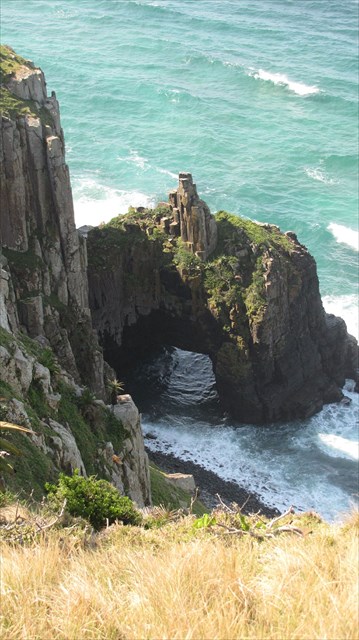The aim of this easy earthcache is to bring you to one of the most impressive geological landmarks along the Wild Coast and help you to understand more about rock formations and erosion that has taken place over millions of years.
An Earth cache is a special type of Virtual Cache that is meant to be educational. Therefore to log a find you must demonstrate that you have learnt something from the site and experience.
Send your answers to us in an email via our profile page.
Any logs not accompanied by an email will be deleted.
Logging Tasks:
1) Optional - Take a photograph of yourself together with your GPSr with the Hole in the Wall in the background and post it with your log.
2) In your opinion what had the greater effect on the erosion of the softer rocks forming the hole and give your reasons.
3) Name two of the softer rock types that have eroded out from under the dolerite found in Ecca sediment to form the hole.
4) Estimate the width in metres of the hole in the wall.

![]()
GEOLOGY
The present east coastline of South Africa (also known as the Wild Coast) was formed more or less as at is today during the break-up of Gondwanaland. Geologically the region is dominated by Beaufort sandstones of the Karoo System with bands of the older Ecca and Dwyka series towards the coast. The actual rocky coastline itself comprises Ecca sediments (consisting mainly of shales and sandstones) with many intrusions therein, mainly in the form of sheets of varying thickness of Karoo dolerite.
The Hole in the Wall cliff is found at the mouth of the Mpako River. The cliff consists of dark-blue shales, mudstone and sandstones of the Ecca Group, dating back some 260 million years. These rocks were subsequently intruded by a dolerite sheet. The “hole” was created over millions of years by erosion of the buffeting waves and the flow of the river, which eroded the softer rocks underneath the dolerite to form an arch. The same processes also eventually separated the cliff from the mainland.
ANOTHER NEARBY SITE
A short distance up the coastline there is a similar rock formation known as “Baby Hole” at S32 01.315 E029 07.417 and can be accessed on the hiking trail from Hole in the Wall to Coffee Bay. The only significant difference is that it is not situated at a river mouth.

![]()
LEGEND
A young girl called Nongqawuse had seen a messenger from the realm of the ancestors at a waterhole. She told her uncle Mhlakaza about her vision. As he was an important Xhosa priest, his social rank granted a great impact to the prophecy he derived from his niece’s vision. He announced that soldiers who were incarnations of the souls of dead Xhosa warriors, would arrive on the 18th of February over the sea, come onto land through the “Hole in the Wall” and defeat the hated British. But, he continued, the Xhosa had to make a sacrifice to help the warriors by destroying all the cereals and killing all their cattle. After the victory, there would be food in abundance for everybody The Xhosa followed the instructions in his prophecy and killed their whole stock of cattle. The catastrophe took its course. Thousands of Xhosa starved to death and the British had an easy time conquering the remaining people.
Acknowledgements to:A Guide to the Coast and Nature Reserves of Transkei by Duncan Butchart in association with The Wildlife Society. Wikipedia